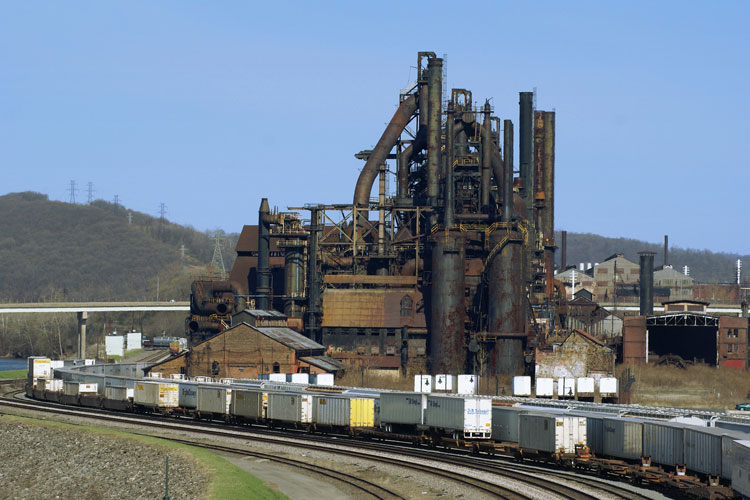Steel Factory workers employ two basic manufacturing processes: the Electric Arc Furnaces process and the Basic Oxygen Furnace process. The Electric Arc process produces hot-rolled shapes, including wide-flange sections, angles and channels. The Basic Oxygen Furnace process produces slabs, beams and billets.
Working in a Steel Factory comes with inherent risks, including one that is not so obvious. Because asbestos was used in steel mills as a common insulation material, workers were exposed to this toxic material while performing their daily tasks.
Regardless of the type of steel mill worker, their exposure to asbestos is usually the result of direct handling machinery, equipment and material in the process of manufacturing steel.
Asbestos insulation used in an abundance of steel mill equipment such as, ovens, hot blast stoves, furnaces, rolling mills, tanks, boilers, cranes, molding boards and steam pipes helped prevent fires and burns, but the fibers it released were toxic. Workers would inhale these fibers as they became involved in the process of manufacturing steel, including feeding the vessels scrap metal by a crane, controlling machinery to then melt the scrap metal and adding other metal to give it the required chemical composition.
As workers became involved in the steel making process, the fibers from the machinery would become lodged in the area of the lungs, often causing scarring. In some cases, tumors would form as well and workers would eventually be diagnosed with mesothelioma cancer.
Workers in metal processing plants and smelters generally have a higher risk of exposure to toxic pollutants since they can come into direct contact with the pollutants when working with substances containing metal processing and smelting waste.
Exposure to airborne pollutants from metal processing and smelting can lead to various acute and chronic diseases. Initial sudden exposure can lead to an irritation of the eyes, nose and throat. More serious and chronic effects are heart and lung problems, and even premature death. Heavy metals also pose chronic health risks including bioaccumulation of toxic elements in organisms, which can result into birth defects, kidney and liver problems, gastrointestinal tract issues, joint pain, as well as nervous, respiratory and reproductive system damage.
Metal Dust is Combustible and is an Explosion Hazard:
When most people think of controlling dust in the workplace, they think of taking steps to avoid inhaling dusts to prevent health problems. However, the accumulation of combustible dusts in the workplace can lead to far greater consequences. As seen in recent years, neglect of housekeeping and improper handling of combustible dusts can lead to property damage, injuries and loss of life.
During fabricating operations, metal fines may be generated by such activities as grinding, polishing, sawing, cutting, sanding or scratch brushing and at least some of them will be fine enough to be potentially explosive. The term “dust” or “powder” is frequently used to describe such particles.
The National Fire Protection Association (NFPA) defines a combustible dust as “a combustible particulate solid that presents a fire or deflagration hazard when suspended in air or some other oxidizing medium over a range of concentrations, regardless of particle size or shape.” In general, combustible particulates having an effective diameter of 420 μm or smaller, as determined by passing through a U.S. No. 40 Standard Sieve, are generally considered to be combustible dusts. However, agglomerates of combustible materials that have lengths that are large compared to their diameter (and will not usually pass through a 420 μm sieve) can still pose a deflagration hazard. Therefore, any particle that has a surface area to volume ratio greater than that of a 420 μm diameter sphere should also be considered a combustible dust. The vast majority of natural and synthetic organic materials, as well as some metals, can form combustible dust. The NFPA’s Industrial Fire Hazards Handbook states, “any industrial process that reduces a combustible material and some normally non-combustible materials to a finely divided state presents a potential for a serious fire or explosion.”
Suggested Industrial Vacuums for Recovery of Toxic & Combustible Dust
PrestiVac HEPAPlus* Vacuums are specifically designed to safely vacuum toxic dusts. Equipped with a Certified Absolute HEPAPlus*filter with an efficiency of 99.995% on 0.2 micron so there is no risk of exposure or contamination for the operator or the environment. These vacuums are tested for absolute filtration. Testing Method: IEST RP-CC034.3. H14. MIL-STD 282 / A.S.T.M. - D2986-91. MPPS method EN 1822.
PrestiVac Explosion Proof/Dust Ignition Protected Vacuums are designed to safely vacuum explosive, flammable, combustible conductive* dusts. Our Explosion Proof/Dust Ignition Protected Vacuums are completely grounded and static dissipating because they are built entirely with non-sparking metals and do not have any painted components so there is no risk of fire or explosion from a spark or static build up. All the electrical components, including the motor and starter are totally enclosed so there is no source of ignition. Our explosion proof vacuum cleaners comply with NFPA 484 guidelines and are an effective tool for good housekeeping practise as per OSHA.
Which Industries are at Risk with Steel Dust?













